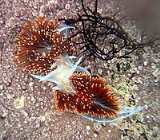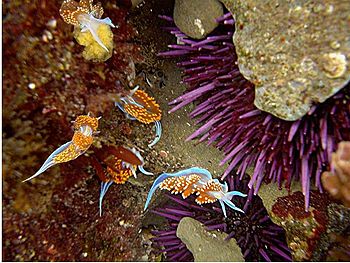
Hermissenda crassicornis
Encyclopedia
Hermissenda crassicornis is a species
of small, brightly-colored, sea slug
or nudibranch
, a marine
gastropod mollusk in the family Glaucidae
.
This species is also commonly known as the "opalescent sea slug."

, Alaska
, to Punta Eugenia, Mexico
.
The species has also been observed in Bahia de los Angeles
, Gulf of California
, and in Japan
.
s, including the intertidal zone
of rocky shores, but also in bays and estuaries
.
s and other marine organisms such as ascidians and sea anemones. It sometimes attacks other nudibranchs, and will eat smaller specimens of its own species.
Species
In biology, a species is one of the basic units of biological classification and a taxonomic rank. A species is often defined as a group of organisms capable of interbreeding and producing fertile offspring. While in many cases this definition is adequate, more precise or differing measures are...
of small, brightly-colored, sea slug
Slug
Slug is a common name that is normally applied to any gastropod mollusc that lacks a shell, has a very reduced shell, or has a small internal shell...
or nudibranch
Nudibranch
A nudibranch is a member of what is now a taxonomic clade, and what was previously a suborder, of soft-bodied, marine gastropod mollusks which shed their shell after their larval stage. They are noted for their often extraordinary colors and striking forms...
, a marine
Marine (ocean)
Marine is an umbrella term. As an adjective it is usually applicable to things relating to the sea or ocean, such as marine biology, marine ecology and marine geology...
gastropod mollusk in the family Glaucidae
Glaucidae
Glaucidae is a taxonomic family of colorful sea slugs. These are specifically aeolid nudibranchs. They are marine gastropod molluscs in the superfamily Aeolidioidea.-Genera and species:Genera and species within the family Glaucidae include:...
.
This species is also commonly known as the "opalescent sea slug."

Distribution
This nudibranch lives from Kodiak IslandKodiak Island
Kodiak Island is a large island on the south coast of the U.S. state of Alaska, separated from the Alaska mainland by the Shelikof Strait. The largest island in the Kodiak Archipelago, Kodiak Island is the second largest island in the United States and the 80th largest island in the world, with an...
, Alaska
Alaska
Alaska is the largest state in the United States by area. It is situated in the northwest extremity of the North American continent, with Canada to the east, the Arctic Ocean to the north, and the Pacific Ocean to the west and south, with Russia further west across the Bering Strait...
, to Punta Eugenia, Mexico
Mexico
The United Mexican States , commonly known as Mexico , is a federal constitutional republic in North America. It is bordered on the north by the United States; on the south and west by the Pacific Ocean; on the southeast by Guatemala, Belize, and the Caribbean Sea; and on the east by the Gulf of...
.
The species has also been observed in Bahia de los Angeles
Bahía de los Ángeles
' is a coastal bay on the Sea of Cortez, located along the eastern shore of the Baja California Peninsula in the state of Baja California, Mexico...
, Gulf of California
Gulf of California
The Gulf of California is a body of water that separates the Baja California Peninsula from the Mexican mainland...
, and in Japan
Japan
Japan is an island nation in East Asia. Located in the Pacific Ocean, it lies to the east of the Sea of Japan, China, North Korea, South Korea and Russia, stretching from the Sea of Okhotsk in the north to the East China Sea and Taiwan in the south...
.
Habitat
It can be found in various habitatHabitat (ecology)
A habitat is an ecological or environmental area that is inhabited by a particular species of animal, plant or other type of organism...
s, including the intertidal zone
Intertidal zone
The intertidal zone is the area that is above water at low tide and under water at high tide . This area can include many different types of habitats, with many types of animals like starfish, sea urchins, and some species of coral...
of rocky shores, but also in bays and estuaries
Estuary
An estuary is a partly enclosed coastal body of water with one or more rivers or streams flowing into it, and with a free connection to the open sea....
.
Description
The species grows to be about 50 mm, or about 2 inches. The color of this nudibranch varies from one locality to another, but it is always easily recognizable by the orange stripe along its back.Life habits
This nudibranch feeds on hydroidHydroid
-Marine biology:Hydroids are a life stage for most animals of class Hydrozoa, small predators related to jellyfish.-Botany:In mosses, hydroids form the innermost layer of the stem of long, colourless, thin walled cells of small diameter.The cells are dead and lack protoplasm.They function as water...
s and other marine organisms such as ascidians and sea anemones. It sometimes attacks other nudibranchs, and will eat smaller specimens of its own species.
External links
- Sea Slug Forum, species fact sheet:http://www.seaslugforum.net/showall.cfm?base=hermcras
Books
- Behrens David W., 1980, ‘’Pacific Coast Nudibranchs: a guide to the opisthobranchs of the northeastern Pacific’’, Sea Challenger Books, California

